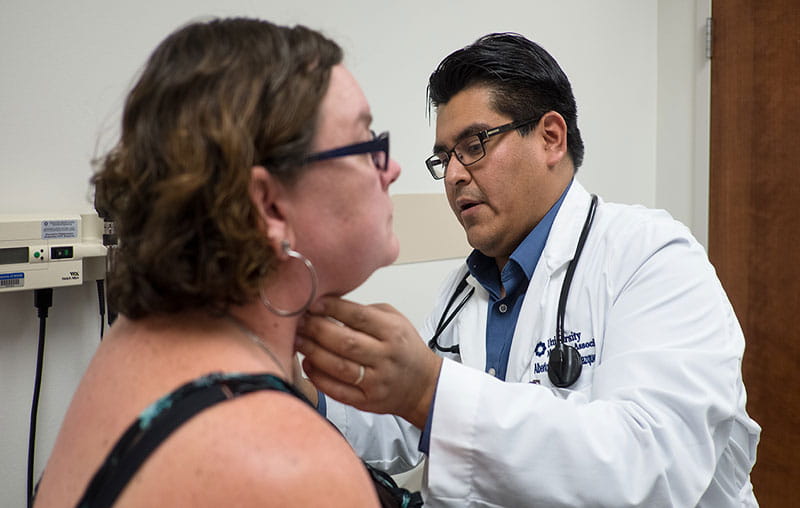Flu season is around the corner and with the threat of COVID-19 still circulating within our communities, we need to do everything within our power to prevent getting the flu. Everyone 6 months and older should get vaccinated.
You can catch the flu any time of the year, but typically it becomes more active in October, peaks in the winter months and tapers off sometime in May.
Medical professionals are bracing themselves for this upcoming season as it’s likely that many people will think they have COVID-19 when they get the flu. To complicate matters further, both respiratory illnesses have strikingly similar symptoms. In many cases, only a definitive test will make it clear as to which illness you have.
According to the Centers for Disease Control and Prevention, both the flu and COVID-19 share a number of symptoms:
- Fever or chills
- Cough
- Shortness of breath or difficulty breathing
- Fatigue
- Sore throat
- Runny or stuffy nose
- Muscle pain or body aches
- Headache
- Vomiting and diarrhea
Doctors now recognize that some unique symptoms of the novel coronavirus may include: a sudden change or loss of smell or taste, blood clots in the veins and arteries of the lungs, heart, legs or brain and in some children the presence of Multisystem Inflammatory Syndrome.
We’ve focused our attention on COVID-19 but let’s not forget that the flu can have severe consequences as well. “Every year there are people who die from the flu. It’s a serious illness and even young people can get critically ill with influenza,” said Dr. Jason Bowling, medical director of infection control and prevention at University Health.
You can get the flu and COVID-19 at the same time
Getting a flu shot this year is crucial, especially because of the ongoing COVID-19 pandemic. Take action to preserve your health and prevent the likelihood of getting both illnesses at the same time.
The CDC indicates there is a test that checks for A and B type seasonal flu viruses and SARS CoV-2 (COVID-19). This type of test will help public health organizations save testing materials in this upcoming flu season and promote the likelihood of faster test results so appropriate medical treatment can begin for each patient.
Although most people experience mild to moderate symptoms, the CDC reminds us that both the flu and the novel coronavirus can result in life threatening complications, some of them include:
- Pneumonia
- Respiratory failure
- Acute respiratory distress syndrome (fluid in the lungs)
- Sepsis
- Heart attacks and stroke
- Multiple organ failure
- Worsening of chronic medical conditions
- Inflammation of the heart, brain or muscle tissues
- Secondary bacterial infections
“Getting a flu vaccine is the smart thing to do,” said Dr. Bryan Alsip, University Health’s Chief Medical Officer. “It’s the single best method for protection against becoming ill with influenza and to protect others from getting the flu.”
Dr. Alsip said babies younger than 6 months old are particularly vulnerable to the flu – that’s why it’s so important that everyone around them is vaccinated. “In addition, the elderly, those with chronic illnesses, pregnant women and residents of nursing homes and other long-term care facilities are also at greater risk of acquiring the disease and flu-related complications,” he said.
Anyone who has chronic medical conditions should stay away from others who have the flu. Influenza can easily aggravate pre-existing health conditions.
Major categories identified as being a high risk of complications for influenza or COVID-19 include: adults 65 years and older, pregnant women, young children, asthma, heart disease & stroke, diabetes, HIV/AIDS, cancer, children with neurological conditions and chronic kidney disease.
When should you get vaccinated?
The CDC and its Advisory Committee on Immunization Practices encourages vaccinations before flu activity begins and they recommend you get your flu shot by the end of October. Keep in mind that children from 6 months to 8 years old who need two doses have to get their first dose as soon as the influenza vaccine is available to allow enough time for them to get a second dose by the end of October. The second dose must be given no sooner than four weeks after the first dose.
So, now is the time to reach out to your family physician to make an appointment for yourself and your kids before the flu season arrives.
How to prevent the flu
CDC recommends three actions to prevent the flu:
- Get a flu vaccine.
- Practice everyday preventive actions.
- Take antiviral medication to treat flu if your doctor prescribes them.
Every flu season takes on a life of its own, presenting with different strains of influenza, the severity of the illness and the length of the season. It’s possible that all the safety measures that we’ve adopted to help prevent us from getting COVID-19 will also help to limit our exposure to the flu this fall and winter (washing hands, physically distancing and wearing masks).
While many of us continue to be COVID-19 focused, it’s critical that we don’t forget the ill effects that the flu can bring. We may not have a vaccine for COVID-19, but we do have access to influenza vaccines to help protect our families and communities. Be proactive. Get your flu shot. More than ever, protecting our health has become a universal goal.
If you want to keep up with flu activity, check out the Weekly U.S. Influenza Surveillance Report put out by the Influenza Division of the CDC or go to the Texas Department of State Health Services for detailed information.





